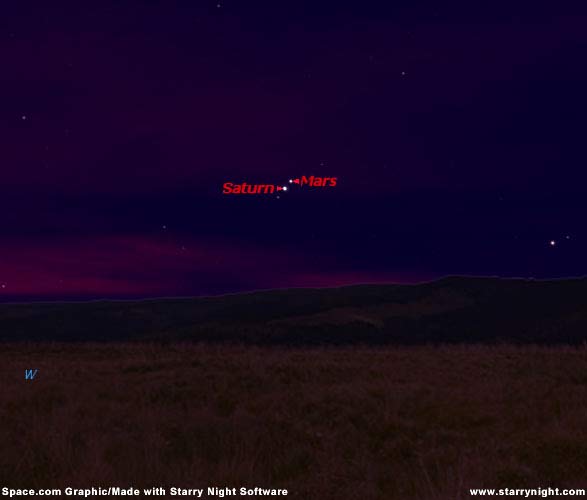Watch Mars and Saturn Converge

Two bright planets are approaching each other in our evening sky.
Mars, which was so brilliant last fall and has since diminished dramatically in brightness, and Saturn, which has adorned our evening sky since midwinter, are currently visible about one-quarter of the way up from the western horizon as darkness falls.
You shouldn't confuse them with the nearby "Twin Stars," Pollux and Castor, in the constellation of Gemini. Mars and Saturn are located above and to the left of the Twins. Yellow-white Saturn, shining sedately at magnitude +0.4, will appear to the upper left of the much dimmer Mars, glowing with an orange-yellow hue.
At magnitude +1.8, Mars now appears more than three and a half times fainter than Saturn.
If you watch the sky carefully during this week, you'll be able to take note of the fact that the two planets are slowly drawing closer to each other, by about a half-degree (the apparent width of the Moon) each night
On the evening of June 17, Mars will appear to pass just to the north of Saturn. They will be separated by 0.56 degrees. [Map]
Despite the difference in brightness, the planets still should make for a rather eye-catching pair in the western twilight glow about an hour after sundown. Mars will appear above and to the left of Saturn; on the 16th it will appear directly to Saturn's right, while on the 18th, Mars will stand directly above Saturn.
Breaking space news, the latest updates on rocket launches, skywatching events and more!
Saturn, at a mean distance of 886 million miles (1.4 billion kilometers) from the Sun, takes 29.46 years to move once around the Sun. Mars, at a mean distance of 141.6 million miles (227.9 million kilometers) from the Sun, requires only 1.88 years to complete that journey. As a result, Mars' normal eastward motion among the stars, as seen from Earth, is considerably faster than that of Saturn, and Mars will periodically seem to overtake Saturn in the sky.
| Mars-Saturn Conjunctions DateSeparation 2000 April 15 2.3 degrees 2002 May 3 2.2 degrees 2004 May 24 1.6 degrees 2006 June 17 0.56 degrees 2008 July 10 0.63 degrees 2010 July 30 1.8 degrees 2012 Aug.14 2.7 degrees | Mars-Saturn Conjunctions DateSeparation 2000 April 15 2.3 degrees 2002 May 3 2.2 degrees 2004 May 24 1.6 degrees 2006 June 17 0.56 degrees 2008 July 10 0.63 degrees 2010 July 30 1.8 degrees 2012 Aug.14 2.7 degrees | Mars-Saturn Conjunctions | DateSeparation 2000 April 15 2.3 degrees 2002 May 3 2.2 degrees 2004 May 24 1.6 degrees 2006 June 17 0.56 degrees 2008 July 10 0.63 degrees 2010 July 30 1.8 degrees 2012 Aug.14 2.7 degrees | Date | Separation | 2000 April 15 | 2.3 degrees | 2002 May 3 | 2.2 degrees | 2004 May 24 | 1.6 degrees | 2006 June 17 | 0.56 degrees | 2008 July 10 | 0.63 degrees | 2010 July 30 | 1.8 degrees | 2012 Aug.14 | 2.7 degrees | Row 0 - Cell 20 |
| Mars-Saturn Conjunctions DateSeparation 2000 April 15 2.3 degrees 2002 May 3 2.2 degrees 2004 May 24 1.6 degrees 2006 June 17 0.56 degrees 2008 July 10 0.63 degrees 2010 July 30 1.8 degrees 2012 Aug.14 2.7 degrees | Mars-Saturn Conjunctions | DateSeparation 2000 April 15 2.3 degrees 2002 May 3 2.2 degrees 2004 May 24 1.6 degrees 2006 June 17 0.56 degrees 2008 July 10 0.63 degrees 2010 July 30 1.8 degrees 2012 Aug.14 2.7 degrees | Date | Separation | 2000 April 15 | 2.3 degrees | 2002 May 3 | 2.2 degrees | 2004 May 24 | 1.6 degrees | 2006 June 17 | 0.56 degrees | 2008 July 10 | 0.63 degrees | 2010 July 30 | 1.8 degrees | 2012 Aug.14 | 2.7 degrees | Row 1 - Cell 19 | |
| Mars-Saturn Conjunctions | ||||||||||||||||||||
| DateSeparation 2000 April 15 2.3 degrees 2002 May 3 2.2 degrees 2004 May 24 1.6 degrees 2006 June 17 0.56 degrees 2008 July 10 0.63 degrees 2010 July 30 1.8 degrees 2012 Aug.14 2.7 degrees | Date | Separation | 2000 April 15 | 2.3 degrees | 2002 May 3 | 2.2 degrees | 2004 May 24 | 1.6 degrees | 2006 June 17 | 0.56 degrees | 2008 July 10 | 0.63 degrees | 2010 July 30 | 1.8 degrees | 2012 Aug.14 | 2.7 degrees | ||||
| Date | Separation | |||||||||||||||||||
2000 April 15 | 2.3 degrees | |||||||||||||||||||
2002 May 3 | 2.2 degrees | |||||||||||||||||||
2004 May 24 | 1.6 degrees | |||||||||||||||||||
2006 June 17 | 0.56 degrees | |||||||||||||||||||
2008 July 10 | 0.63 degrees | |||||||||||||||||||
2010 July 30 | 1.8 degrees | |||||||||||||||||||
2012 Aug.14 | 2.7 degrees | |||||||||||||||||||
| Row 12 - Cell 0 |
Interestingly, when we combine the motions of Earth, Mars and Saturn, we find that the interval between Mars-Saturn conjunctions averages about every 2 years and 20 days. The upcoming conjunction will be the closest one from 2000 through 2012 (although the one in July 2008 will be very nearly as close).
Bonus views
In addition to Saturn and Mars, those using binoculars will also be able to see the famous Beehive Star Cluster in the same field of view.
Mars, in fact, will appear to pass directly through the center of the cluster on the evening of June 15. Wait until the sky has become sufficiently dark (about two hours after sunset) to get your best view of the fainter stars of the cluster.
And as a final touch, if you look far down to the lower right of Mars and Saturn about 45 minutes after sunset, you may catch a glimpse of yet a third planet, Mercury, hovering low above the west-northwest horizon. It should appear as a yellowish "star" shining a bit brighter than Saturn.
On the evening of June 9 make sure you don't confuse Mercury with the similarly bright stars Capella and Procyon which will be positioned far to its right and left, respectively. On June 11, Mercury will appear directly below Pollux and Castor, forming an isosceles triangle with those two stars.
Basic Sky Guides
- Full Moon Fever
- Astrophotography 101
- Sky Calendar & Moon Phases
- 10 Steps to Rewarding Stargazing
- Understanding the Ecliptic and the Zodiac
- False Dawn: All about the Zodiacal Light
- Reading Weather in the Sun, Moon and Stars
- How and Why the Night Sky Changes with the Seasons
- Night Sky Main Page: More Skywatching News & Features
Joe Rao serves as an instructor and guest lecturer at New York's Hayden Planetarium. He writes about astronomy for The New York Times and other publications, and he is also an on-camera meteorologist for News 12 Westchester, New York.
| DEFINITIONS |
1 AU, or astronomical unit, is the distance from the Sun to Earth, or about 93 million miles. Magnitude is the standard by which astronomers measure the apparent brightness of objects that appear in the sky. The lower the number, the brighter the object. The brightest stars in the sky are categorized as zero or first magnitude. Negative magnitudes are reserved for the most brilliant objects: the brightest star is Sirius (-1.4); the full Moon is -12.7; the Sun is -26.7. The faintest stars visible under dark skies are around +6. Degrees measure apparent sizes of objects or distances in the sky, as seen from our vantage point. The Moon is one-half degree in width. The width of your fist held at arm's length is about 10 degrees. The distance from the horizon to the overhead point (called the zenith) is equal to 90 degrees. Declination is the angular distance measured in degrees, of a celestial body north or south of the celestial equator. If, for an example, a certain star is said to have a declination of +20 degrees, it is located 20 degrees north of the celestial equator. Declination is to a celestial globe as latitude is to a terrestrial globe. Arc seconds are sometimes used to define the measurement of a sky object's angular diameter. One degree is equal to 60 arc minutes. One arc minute is equal to 60 arc seconds. The Moon appears (on average), one half-degree across, or 30 arc minutes, or 1800 arc seconds. If the disk of Mars is 20 arc seconds across, we can also say that it is 1/90 the apparent width of the Moon (since 1800 divided by 20 equals 90). |

Joe Rao is Space.com's skywatching columnist, as well as a veteran meteorologist and eclipse chaser who also serves as an instructor and guest lecturer at New York's Hayden Planetarium. He writes about astronomy for Natural History magazine, Sky & Telescope and other publications. Joe is an 8-time Emmy-nominated meteorologist who served the Putnam Valley region of New York for over 21 years. You can find him on Twitter and YouTube tracking lunar and solar eclipses, meteor showers and more. To find out Joe's latest project, visit him on Twitter.
